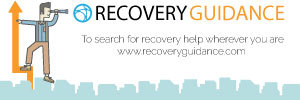Leslie Glass's Blog, page 427
November 7, 2017
Threat Of Violence From An EX
I drove home while chatting excitedly on the phone with my best friend, she was leaving for a wedding out of state and I was readying to meet my new students the next day; we were both enthusiastic and grateful for the new experiences.
My driveway is partially hidden from view of the street by massive trees which bend with the usual weight of the leaves and today, with the added weight of the water that was collecting in droplets and dripping onto the cement. New friends would often whiz right past, even as their GPS announced that they had arrived. The driveway took on the appearance of a tunnel and we joked that I was entering the bat cave. “Coming in hot, Alfred!” made us both chuckle at the Batman reference from our youth.
My house lay nestled in an opening in the trees which encircle the property like a giant hug. This time of year, there are yellows and reds and oranges tucked between evergreens as the color wheel makes its presence known. My little retreat from the world, a place to recharge and refresh my soul. A home that I purchased on my own for the first time, and a place that has allowed me to heal and then to choose my next path. I just love it here. Hearing the greeting of my dogs who had already busted out their door and were waiting for me to park and play, my friend was saying her goodbyes when a truck pulled into my driveway. I didn’t recognize the vehicle, and she stayed on the line.
The driver rolled down the window and I recognized him as my ex-boyfriend. I was instantly outraged; what was he doing here? We had broken up eleven months prior and he was blocked from communicating with me in any fashion: email, phone, and social media. The emotional and verbal abuse and manipulation that I had allowed in the relationship, was something that I would no longer allow and I had remained out of communication. He had tried to reach me through mutual friends, who would relay his messages until they, too, stopped communicating at my direction.
It would be easy to say that his behavior led to the breakdown of our relationship, but, the truth is that I allowed it. I was at a point in my life where I felt scared and vulnerable and his promises were exactly what I wanted to hear. Never mind that they weren’t genuine, I told myself that he was what I wanted and I went with it. All the way up until I didn’t. The constant arguing and berating was exhausting, and I found myself showing up as less and less of who I really was. I lost my voice and gave away my power; I felt more scared and more vulnerable and when I reached disempowered – I began to detach and see him for who he really was standing in front of me and not who I wanted him to be. And I broke up with him. Our relationship lasted a mere seven months. ‘I don’t ever want to be in communication with you again. Not now. Not ever.’ he heard as ‘I’ll give you some time to come to your senses and then we can talk.’ And the more I remained out of communication, the more insistent he became about trying to communicate with me. And then he showed up at my house.
He was saying something I couldn’t hear over the barks of the dogs, and had brought the palms of his hands together as if praying and was bobbing them back and forth in my direction; his truck blocking my driveway. I sat paralyzed for a moment, I felt trapped and unsafe. ‘Don’t get out of the car’ was my friend’s instruction. It took a split second for the outrage to morph into flight as the adrenaline kicked in, and I drove onto the grass and around his vehicle and out the driveway to a public place. A couple miles up the road, I pulled into a church parking lot and tucked my car close to the building and waited, engine running, for him to pass so that I could go back home. She stayed on the phone with me the whole time, offering support and giving me direction. Finally, he drove past and spotting me as I pulled out, he yelled something in my direction that I couldn’t hear. I drove home, pulled my car into the garage and locked all the doors. This was not the first time that his behavior had scared me. But this time, I called the police and the possibility of a restraining order became real.
It embarrasses me a little to relay this incident and the ramifications of my getting involved with a guy who was, clearly, not the guy for me. But, it happened and it’s time to forgive myself for taking that route and focus on what I learned instead.
Reach Out Recovery Exclusive By Elizabeth Viszt
If you need help with relationships, click on the image below for a free resource to locate mental health professionals near you.
The post Threat Of Violence From An EX appeared first on Reach Out Recovery.
November 6, 2017
What Is Conflict Resolution

cartoon fighters with gavel at hand
Who decides what’s right and what’s wrong when people disagree or have a problem to solve? How should we behave? Families, workplaces, the playground all have certain codes of conduct. In government we have a code of conduct, too, but it doesn’t always work. Conflict resolution is something we all need right now.
What Is A healthy Conflict Environment
Here’s Are 4 Components That Make A Safe Place To Explore Issues
Everyone has an equal voice. No one can dominate by battering.
Everyone’s opinion matters. Really.
Everyone behaves on a mature way, leaving baggage from family of origin behind.
Ethics and principles of fair play are the guides for finding solutions that work for everyone.
Basic Questions To Ask Yourself Before Starting
How is this one particular conflict affecting the whole group dynamic.
Am I actively listening to others and not reacting to them?
Do I let others voice their opinions and ideas.
Am I helping to find a resolution or hindering by making it all about me.
Unity Means
We are not all right or we are not all wrong – In conflict resolution we look for the balance in the situation. Despite the disagreements, we look to serving the common goal. We are all trying to reach the goal, but perhaps each has a different route. Do I set aside my differences in order to resolve the conflict is a question that you should ask yourself.
Ask yourself – Despite the conflict what is the single purpose we are trying to achieve? What is our united focus? Can we leave other issues outside of this one discussion and not add fuel to the fire by brining on other issues or conflicts?
Mutual Respect Is Key
in a healthy conflict situation we intentionally set aside our personal power or authority, it’s not about winning or losing but rather arriving at a common destination. Here are seven questions everyone should ask themselves as they begin the resolution process.
Do I keep an open mind? And respond rather than react to the parties involved?
Do I have compassion and understanding for all who are involved in this one issue and conflict?
How can I show kindness to others whose opinions are different than mine?
Do I know and acknowledge that there is abundance in the universe and I do not have to make fear based decisions?
Do I fear that I might be left without if our conflict leads us to disagree with each other?
How do I communicate my personal experience in an improved communications manner in the current discussion?
How do I remind myself that while in conflict I share as equal, not less than the other parties involved and not more?
How do I not get distracted by other issues that are not related to the conflict?
I have to remind myself that while there is a conflict, I am not being attacked personally, but rather I will work with others to find solutions to the issue at hand. We need this in every area of life.
Reach Out Recovery Exclusive by Gila Meriwether
The post What Is Conflict Resolution appeared first on Reach Out Recovery.
April 17, 2012
Help Us Reframe the National Dialogue on Addiction and Recovery
Reach Out Recovery has a big dream. We want to become the United Way of Recovery, raising funds to support the thousands of existing programs all across the country that currently are unknown to the general public. How can we do it? ROR is creating the media tools to raise awareness and create the recovery friendly environment that is crucial to make Recovery Giving a national priority. The first step is to show the nation that recovery is worth the investment. We believe, as with cancer, HIV, diabetes, heart disease, the public will support treatment for a chronic disease that is manageable. Partnership of Drug Free American reported last week that 23 million Americans are in recovery. If each gave a dollar back for their lives, a new feeling of “national” community would be launched. Corporations that now stay away from recovery causes, will begin to support it. Tens of thousands of lives will be saved every year. With their two documentaries, “The Secret World of Recovery” and “The Silent Majority,” Leslie and Lindsey Glass have begun to tell the story that education, prevention and recovery work. Now ROR media campaign begins at the Prism Awards in Los Angeles.
Support our effort and help us save lives. Every dollar raised goes directly, either to a nonprofit recovery or education organization, or to the ROR film or media fund.
ROR is Proud to Join SAMHSA Recovery Planning Partnership
March 28th Leslie and Lindsey traveled to Washington for the second week in a row. This time they went to SAMHSA’s (Substance Abuse and Mental Health Services Agency, a division of Health and Human Services) headquarters in Rockville, MD to join SAMHSA’s Recovery Planning Partnership for the first time. It was an honor to meet addiction and recovery professionals from all over the country. This recovery partnership represents a wide variety of organizations that provide many kinds of services, education, and community outreach all across the nation. ROR looks forward to getting to know all the participants and helping to tell their stories and finding innovative ways to support them.
First Screening of The Silent Majority at the Washington Hilton, April 10, 2012
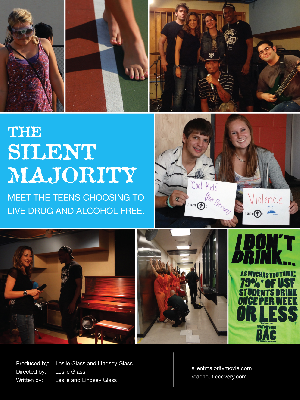
Leslie and Lindsey were in Washington D.C. for a third week in a row to participate in the Joint Meeting on Adolescent Treatment Effectiveness (JMATE), “collaborating and integrating to support youth and families in an Era of Change.”
The Silent Majority has its very first screening, and an enthusiastic audience said they loved the movie. “Beautifully done. It brings real stories of hope and excitement to a field that needs tools to show that prevention and recovery work,” was the kind of praise we heard. Networking with 1100 treatment providers and recovery experts and advocates was a great learning experience. Lindsey and Leslie were proud to be presenters.
ROR To Film at The Prism Awards on April 19th
In collaboration with the Entertainment Industries Council, Reach Out Recovery will launch its media campaign by filming at the Prism Awards on April 19th at the Beverly Hills Hotel in Los Angeles. Leslie and Lindsey will interview attendees and award winners and do a behind the scenes look at Recovery on TV and in the movies. You’ll see some of it on YouTube following the event.
Call to Action
ROR can’t change the world on its own. We need your help. In addition to speaking out for Recovery in the national arena, we are working on:
Events to launch “The Silent Majority” and ways to use the film as part of existing programs in a variety of non profits.
We are developing a Media Campaign–six public service commercials that will run all over the world forever for free. For this initiative, we need $20,000 for cameramen, editing, and graphics. And we need real people to appear on camera.
To donate to the campaign (Click here)
For an event, or to help with the media campaign and be in a spot, contact us. (Click Here)
April 10, 2012
American Teens
American teens are facing more pressure and access to more dangerous drugs than ever before. With no standardized national program for drug prevention and education, kids are starting their experimentation with drugs at younger and younger ages and are unaware of the deadly consequences. 38,125 teens died last year from prescription drug overdoses alone, surpassing the national number of traffic fatalities. The numbers are staggering and the cost to the nation and the families is incalculable. Why isn't there an impassioned national dialogue about this?
It may seem daunting, almost impossible on a national level, to invest in solutions for this devastating teen epidemic that's affecting our most precious resource, our children. But there are some bright spots, some effective prevention programs scattered around the country that inspire teens to make good choices.
For me, exploring this issue of programs for teens that work in a documentary has been especially meaningful. I know how easy it is for young people get on the wrong track, and how hard is it to get back on the right one. Positive programs, role models and mentors are desperately needed all the way through middle school and high school, even college, to teach life skills. And a new concept of cool.
The programs we highlight in The Silent Majority are changing both lives and communities. The great kids we interviewed for this show told us what teen court, drug free youth and Road Recovery means to them. When given a choice, programs like these are what they want.
Support For Teens
Support for teens, who don't want to take drugs or drink, is a new concept. Getting high or drunk used to be a rite of passage. But using alcohol and substances is no longer a safe coming-of-age ritual. These days prevention should be viewed as a necessity, not a luxury. We now know that 15 of every 100 teens are addicts or will become addicts. If they don't start using until they are of age, they have a better chance of avoiding the disease.
At the same time, ongoing support for teens coming out of rehab is also a brand new idea. Most people think a few months of sober living can turn a life around and are surprised and angered when it doesn't work. But recovery experts know that it takes much more than just not using to recover from addiction. New ways of living and having fun have to be developed to change habits and brain patterns. Imagine how engaging and exciting it must be as a teen coming back to life after drug use with the opportunity to play in a band and be mentored by music industry professionals.
The programs in Silent Majority, Road Recovery and young offenders in Teen Court give kids the opportunity to replace their bad habits with good ones. They teach young people the value of learning skills and fostering a community all under the supervision of professionals who understand the issues involved with addiction and recovery in teens. This mentoring model is proving to be incredibly successful for the recovery process in teens, and more programs needs to be initiated all over the country. We hope that viewers seeing these programs will be the catalyst for creating others all over the country.
Making A Documentary
Making a documentary about teens in recovery was an amazingly rewarding experience for so many reasons. I loved meeting the kids, some of whom show remarkable resilience. I loved profiling the programs that are working successfully in the areas of education, prevention and recovery. And, I loved meeting the people who make these programs work. These leaders are a special kind of dedicated. Getting the opportunity to experience, and film, all these elements working together was not only enlightening about problems and problem solving, but also inspiring. You can't help feeling hopeful that there is a way to help kids.
Working on this movie has been especially meaningful for me because there isn't much available for teens on TV and film that offers a cool alternative to hard drinking and hard partying for having fun.
We hope that showing the University of Tampa, and University of South Florida Harm Reduction program, will inspire other colleges and universities to teach how to calculate BAC, blood alcohol concentration. Less alcohol abuse will help to lower the assaults, date rapes, and various other drinking related crimes and injuries that presently endanger so many college students. Alcohol is so prevalent, yet college students and their parents are not aware of the consequences.
It's crucial that the American public, and particularly teens and preteens get a clear picture of what happens with alcohol and substance abuse, but also how to avoid it, get out of it if you're in it, and recover from it.
We're particularly proud of the D-FY Drug Free Youth of North Port segment of the movie. For kids to be able to join other kids in sober society in high school is exciting in so many ways. First, for presenting an environment that is safe. Second, for promoting the choice to stay off drugs as exciting, positive, and rewarding, rather than the choice of the kids who are less than "cool."
The need of programs for kids who have joined recovery in high school or college is particularly vital because we now know it takes years of positive reinforcement for recovery to work. We know kids don't just get out of rehab and do well. They need a community and activities to keep them engaged in a positive way.
The Job Of A Reporter
The job of a reporter is to ask hard questions about painful issues, to uncover the facts, and to show the alternatives that are providing solutions, or can provide solutions in the future. This is Lindsey's and my mission. In The Silent Majority, we wanted to show what can work to improve our communities instead of reporting on what isn't working. The nation already knows what isn't working. Lack of education in middle school, high school and college about alcohol and substances doesn't work. Ignoring the situation isn't working.
Corporate slogans, like Just Do It, may work for exercise, but Just Say No didn't work for teens because No doesn't offer a positive alternative to Yes.
The DARE and other programs send police officers into schools when using intoxicants is a social and cultural issue that should be addressed by teachers, parents, peers and mentors.
Addiction is universal. Everybody uses something, and no one wants to stop. How do we teach families and children to make distinctions between addictions that do not cause harm, and those that do. Addiction sends millions of people to jail and prison, but 75% of addicts never receive treatment. Without education and treatment the epidemic of addiction can only get worse.
How do we teach positive choices to our children without being repressive? How can the media cover addiction with dignity and respect? How do we tell the recovery story without exploiting the addict in the worst stages of active use? What is our education initiative in this area? These are the questions we are beginning to address with a new kind of documentary.
"The Silent Majority" shows three programs that go beyond telling kids what not to do. For more information: Contact us.
We’re Helping to Reframe the National Dialogue on Addiction and Recovery
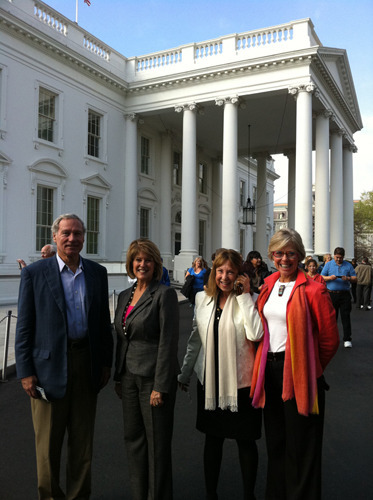
Last week was Washington Week for Leslie and Lindsey Glass. On Monday, Leslie joined the White House Business Council for a “Conversation with Tampa, Orlando, and Jacksonville, FL Business Leaders” to learn about White House Business Partnership Opportunities. Leslie joined Roxie Jerge, Teri Hansen, Joel Fedder, Ken and Barbara Edelin, Ed and Sheila Crego as representatives from Sarasota, which is not considered an entity on its own.
This 5-hour briefing was an eye-opener for the 90+ Florida business leaders in attendance, and was the largest of the 40 get-togethers the White House has organized to date. The purpose of the meeting was to encourage business partnerships between local and national businesses and a wide range of government agencies. The meeting provided real information about what is going on in the Obama administration to spur innovative business ventures. We had face time with 16 senior White House advisors and directors and left with a new understanding and respect for the efforts the administration is making to create economic growth in every state. There is a lot more positive work going on than we hear about from any source.
Lindsey Glass Speaks at Congressional Briefing
Then the week got even better. On Thursday, March 22, speaking for the 23 million people who are not currently receiving any treatment for addiction, Lindsey went to Congress and spoke to a standing-room only crowd of Congressional aides and addiction professionals with a ten-minute speech about how recovery works. She was on the roster with Dr. Laura Nelson Chief Medical Officer, Arizona Department of Health Services, Mark Stringer, Director State of Missouri Department of Mental Health, Divisions of Alcohol and Drug Abuse and Sheriff/Coroner Brian Gootkin, Gallatin County, Montana. Lindsey was honored to speak on behalf of Faces and Voices of Recovery and NASADAD.
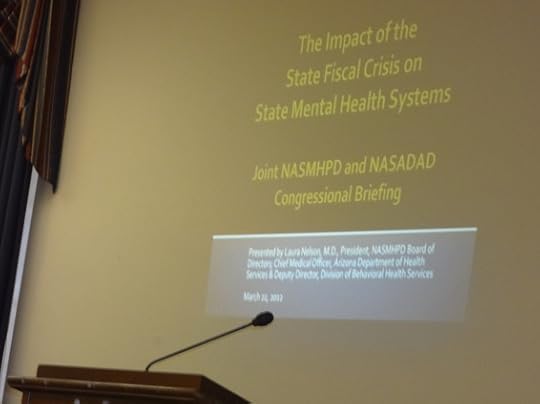
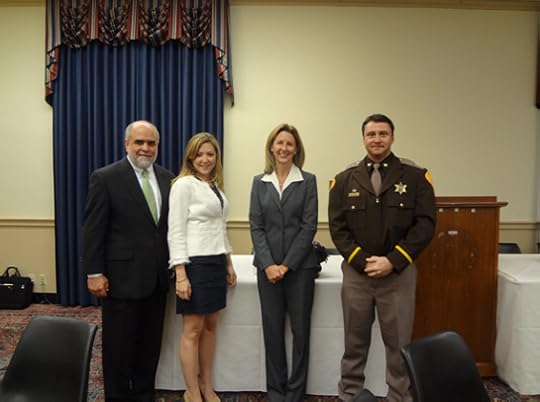
ROR Received a $10,000 Grant from an Anonymous Donor
A thousand thanks go to a beloved Sarasota donor, who contributed $10,000 to the ROR Film Fund for final editing of The Silent Majority, and design of The Silent Majority Website. This donor has no personal experience with addiction, but has a long and rich history supporting education projects for children and teens. The donor saw the movie, immediately responded to its potential for inspiring teens both local and nationally to make healthy choices about alcohol and substances. The donor wishes to remain anonymous.
“The Silent Majority” will have its first public screening at the JMATE convention in Washington D.C. on April 10. For more information, contact us.
ROR Goes to Hollywood
Leslie and Lindsey have been invited to The Entertainment Industries Council Prism Awards in Los Angeles on April 19th.The Entertainment Industries Council (EIC) honors films and television programs that make a positive difference in the world honoring film and TV programs which portray realistic depictions of dependence, in an annual, star-studded, televised awards show. They are now in talks to film behind the scenes interviews to launch their “Recovery Works” media campaign later this year.
Call to Action
ROR can’t change the world on its own. We need your help. In addition to speaking out for Recovery in the national arena, we are working on:
Events to launch “The Silent Majority” and use the film to enhance existing prevention, education, and recovery programs.
We are developing a “Recovery Works” Media Campaign–six public service commercials that will run all over the world forever for free. For this initiative, we need $20,000 for cameramen, editing, and graphics. And we need real people to appear on camera.
To donate to the campaign (Click here)
For an event, or to help with the media campaign, contact us. (Click Here)
We're Helping to Reframe the National Dialogue on Addiction and Recovery

Last week was Washington Week for Leslie and Lindsey Glass. On Monday, Leslie joined the White House Business Council for a "Conversation with Tampa, Orlando, and Jacksonville, FL Business Leaders" to learn about White House Business Partnership Opportunities. Leslie joined Roxie Jerge, Teri Hansen, Joel Fedder, Ken and Barbara Edelin, Ed and Sheila Crego as representatives from Sarasota, which is not considered an entity on its own.
This 5-hour briefing was an eye-opener for the 90+ Florida business leaders in attendance, and was the largest of the 40 get-togethers the White House has organized to date. The purpose of the meeting was to encourage business partnerships between local and national businesses and a wide range of government agencies. The meeting provided real information about what is going on in the Obama administration to spur innovative business ventures. We had face time with 16 senior White House advisors and directors and left with a new understanding and respect for the efforts the administration is making to create economic growth in every state. There is a lot more positive work going on than we hear about from any source.
Lindsey Glass Speaks at Congressional Briefing
Then the week got even better. On Thursday, March 22, speaking for the 23 million people who are not currently receiving any treatment for addiction, Lindsey went to Congress and spoke to a standing-room only crowd of Congressional aides and addiction professionals with a ten-minute speech about how recovery works. She was on the roster with Dr. Laura Nelson Chief Medical Officer, Arizona Department of Health Services, Mark Stringer, Director State of Missouri Department of Mental Health, Divisions of Alcohol and Drug Abuse and Sheriff/Coroner Brian Gootkin, Gallatin County, Montana. Lindsey was honored to speak on behalf of Faces and Voices of Recovery and NASADAD.


ROR Received a $10,000 Grant from an Anonymous Donor
A thousand thanks go to a beloved Sarasota donor, who contributed $10,000 to the ROR Film Fund for final editing of The Silent Majority, and design of The Silent Majority Website. This donor has no personal experience with addiction, but has a long and rich history supporting education projects for children and teens. The donor saw the movie, immediately responded to its potential for inspiring teens both local and nationally to make healthy choices about alcohol and substances. The donor wishes to remain anonymous.
"The Silent Majority" will have its first public screening at the JMATE convention in Washington D.C. on April 10. For more information, contact us.
ROR Goes to Hollywood
Leslie and Lindsey have been invited to The Entertainment Industries Council Prism Awards in Los Angeles on April 19th.The Entertainment Industries Council (EIC) honors films and television programs that make a positive difference in the world honoring film and TV programs which portray realistic depictions of dependence, in an annual, star-studded, televised awards show. They are now in talks to film behind the scenes interviews to launch their "Recovery Works" media campaign later this year.
Call to Action
ROR can't change the world on its own. We need your help. In addition to speaking out for Recovery in the national arena, we are working on:
Events to launch "The Silent Majority" and use the film to enhance existing prevention, education, and recovery programs.
We are developing a "Recovery Works" Media Campaign–six public service commercials that will run all over the world forever for free. For this initiative, we need $20,000 for cameramen, editing, and graphics. And we need real people to appear on camera.
To donate to the campaign (Click here)
For an event, or to help with the media campaign, contact us. (Click Here)
February 10, 2012
Nominated for a 2012 Voice Award
About the Voice Award
Sponsored by the Substance Abuse and Mental Health Services Administration (SAMHSA), the Voice Awards honor consumer/peer leaders who have done exemplary work promoting the social inclusion of individuals with behavioral health problems. The awards also recognize TV and film writers and producers that incorporate dignified, respectful, and accurate portrayals of individuals with behavioral health problems into their scripts, programs, and productions.
The 2012 Voice Awards ceremony will take place on Wednesday, August 22 at Paramount Studios in Hollywood, CA. The event brings together people from the entertainment industry and behavioral health community for a night that celebrates increased awareness of mental health and substance use disorders and the power of recovery.
For more information about the Voice Awards, please visit www.voiceawards.samhsa.gov.
For information about using The Secret World for an event or fundraiser, contact us.

